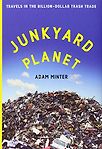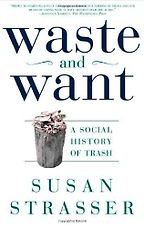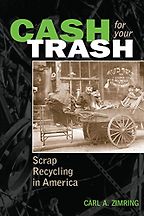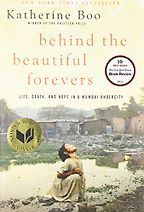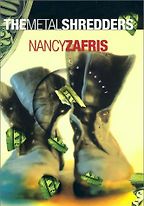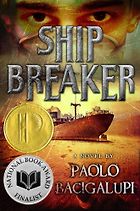Trash is out of sight, out of mind for most of us – but you grew up on a scrapyard. Can you tell us a little about what scrap has meant for you since your childhood?
If you grow up with anything you take it for granted, and I grew up with something that other people take for granted in quite a different way. My great grandfather came to the United States with pretty much nothing to his name, and he started scrapping – that is, he started picking up rags off the street in Galveston, Texas, because it was the only employment option really available to him. He would take those rags and sell them to paper mills – or if they were in good shape, they would be washed and turned into new rags, to use in people’s homes. And that business turned into the business I grew up in, which is a scrap metal yard in Minneapolis, a small warehouse where we would buy everything from the cans that Sunday afternoon football fans would generate to the manufacturing cast-offs from local machine shops that were making parts for the Ford auto plant up the street.
So I grew up in a warehouse, literally surrounded by the stuff that other people didn’t want – and knowing that if we bought it smart, we could sell it smart. I think that growing up seeing value in what other people don’t value is something that I bring to all my endeavours, including journalism – where you try to find those pieces of information that other people overlook and try to transform them into something of more value. So growing up around other people’s waste makes you conscious of your own, but also the ethic from it really suffused how I have approached my life and my profession in general.
How did you get from there to halfway across the world in China?
I knew the publisher and editor of a scrap metal trade journal in the US, and they wanted to get someone to write about what was going on in China in the early 2000s. At that time, the US was shipping enormous quantities of scrap metal and paper to China. Nobody knew exactly what the story was, they were very keen to have it, and I was keen to get out of Minnesota and try my hand at some foreign correspondent work. So I jumped at the opportunity, and came thinking I’d be here for a couple of weeks, maybe a month at most, and then go back to normal life in the US. But I found China so fascinating, and I kept extending my stay, one month at a time. Then it became a couple of years, and five years, and now I’m in year eleven.
Did you know as a child that some of the scrap was being sent to China?
I did. Some of my earliest memories of the business were actually of Taiwanese scrap traders coming to buy our scrap to export to Taiwan. The Chinese scrap business as we know it was, in a way, invented by the Taiwanese in the 50s and 60s. In fact, the Taiwanese were initially brokering a lot of American scrap into China. And of course it’s not just American waste coming over to China – it’s European and also increasingly South East Asian waste that has been going to China. So I knew it was going on, but like a lot of people in the business I hadn’t given much thought to why it was going over and what was happening to it.
Junkyard Planet is the first book to lift the lid on precisely that. What do you want the reader to take away from it?
There’s a couple of messages that I really wanted to get across. Number one, that the recycling business is not a niche, and not just responsible for “green products”. In the US you get greeting cards made from 50% recycled content, and I think those kinds of products tend to make people think it’s a niche, specialised industry. But it’s much bigger than that. Pretty much anything you can buy is affected in its pricing by scrap, and it quite likely has scrap in it. Every automobile, for example, is to some degree made from scrap materials, such as the engine block, if it’s made from aluminium, or the plastic of the bumpers. So I wanted people to realise that recycling is more than just a blue and green bin in their pantry.
The second message, and it’s a very personal message for me, is that there’s dignity in this kind of work. The images that we see of scrap workers, on television for instance, are often of exploited masses in China, Africa, India. There’s more to it than that. These are real, three dimensional people, and there is dignity and entrepreneurship in the work that they do. It’s often an opportunity to lift themselves up from a lower standing. Although many of them don’t, it’s certainly incorrect to look at them as exploited. They are the masters of their own destiny, and making the best of whatever situation this modern world and this modern economy has given them.
The book is a travelogue of sorts, and takes us from back alley to factory. It also reads, in parts, as an encomium to the scrap industry. One of the points you make it that it’s less harmful to the environment to make something from scrap than it is to make it from scratch.
Exactly. And I think that’s provably true. There’s all kinds of data showing that, for example, making an aluminium can from an old beer requires roughly 80% less energy than digging the bauxite ore out of the ground, say somewhere in Tibet, and turning it into a new can that way. And on top of the energy savings, there are also savings because you’re not mining and drilling – you’re using resources that have already been extracted from the ground. The worst recycling is still better than the best mining.
One of the ways I try to show this in the book is to take the reader up to northern Minnesota, the edge of the wilderness, a beautiful area of lakes and forests, that is likely going to have a very large copper mine built on the edge of it. That gives a sense of the destruction before it happens. Extracting raw materials – whether out of the ground or out of copper wire sent to China – is going to be destructive and require energy, but you’re going to be much happier with the environmental destruction caused by recycling than you are by that caused by mining.
But there’s still a responsibility to recycle in as clean a way as we can, right? Which China doesn’t have a particularly good track record with.
Right. I don’t want people to misinterpret me as excusing some of the environmentally abusive practices that I write about. Some of what I’ve seen over the years is abhorrent. Responsibility for that kind of thing lies with a lot of people, not just governments. It lies with consumers, and this modern consumer society that we all embrace and continue to support. So I want to widen the lens of the discussion, from how we throw away things, which is just one part of it, to how we consume. The responsibility of consumers is not just to throw things away well, but we also have to take a certain amount of responsibility for generating that amount of garbage in the first place.
Let’s delve a little into the history of trash, with your first book choice, Waste and Want by Susan Strasser. Can you introduce the book for us?
I can’t say enough good about this book. It’s one of the great social histories written in the last twenty years. It broadly focuses on something that I wish more Americans and more Chinese would think about, and that is the history of American wastefulness. One of the things Strasser does which is so valuable is she resurrects the history of American thriftiness. It’s very funny to bring this up with some people, because we all have this image of the wasteful American – but that wasn’t broadly true even 75 years ago.
The US was a colony, and even though it had access to a lot of raw materials it was a very poor place. When you’re out on the frontier, you use everything you have. And that ethic of reuse and thriftiness – which I guess you could say is a Protestant ethic – persisted in American culture into the 1950s, until the development of the modern American consumer and modern American marketing. Strasser talks about how the American housewife had traditionally been the centre of thrift in a household, but marketers transformed her into a consumer who was using disposable products and generating waste on a scale that no household in human history has seen before. One of the most famous chapters in the book – one that makes some people cringe a bit – concerns the development of the disposable sanitary napkin, which believe it or not has a fascinating history that traces American development from a society that re-uses into one that disposes.
The other thing that Strasser covers is the profit motive that’s long driven the recycling industry. On the scrap metal side of things, Strasser writes about the scrap metal drives during World War Two, the idea that we all needed to help the American military industrial complex collect metal to make weapons to help our boys overseas. Strasser points out that it was a very well intentioned idea, but wasn’t actually very effective at getting the metal delivered to the factories that needed it. A much more attractive, profitable and efficient way of doing this was to let the small scrap businesses do it, which had a profit motive. It’s an absolutely magnificent book, and anyone interested in the subject should read it. It’s very well written as well.
So it’s also the history, in a sense, of how we got hooked on goods.
Right. How we got hooked on goods, and started filling up our landfills. It was a slow process, but you really started to see the beginnings of it in the 1920s, with companies building for obsolesence. The question of whether American automobile companies built their cars to wear out is a controversial one. But by the 1950s something had changed. American wealth had reached a point where they could waste more, and that drove the development of this wasteful consumer culture.
Cash for Your Trash by Carl Zimring is a history of scrap recycling in America, which starts even earlier, in colonial times.
Carl Zimring is a marvellous historian, and he’s done the legwork of putting together the data and history to show that this is not a new business. He dove into the statistics from the 19th century, that showed England had been exporting rags and steel to the US as early as the 1850s. The idea that the scrap export trade started with the US dumping things on China is completely wrong. So long as there was a demand for raw materials and there were the logistics to fill it through recyclables, there was a scrap export trade.
Zimring goes into the colonial period and discusses how small companies – by which I really mean small family workshops – at the time of the industrial revolution would go door to door for people’s old metal pots and pewter mugs. They would buy them, bring them home, and melt them down in blacksmith shops. That really is the origin of the scrap trade. He covers the US, but of course this process also happened in the UK and everywhere else where the industrial revolution was going on, with the suddenly intense demand to make stuff.
Zimring puts together in a very readable way the true outlines of what this business looked like before we even had the word “recycling” – which actually didn’t exist until the 1920s and didn’t properly come into its modern usage until the 1960s. Of course if you want to go further back, the scrap recycling industry has been around ever since someone suggested beating a sword into a plowshare…
Recycling is now a green movement, and most people are aware that they should be doing it, even if they don’t. When did that attitude emerge?
That’s something that Susan Strasser covers in her book as well. It started to emerge in the late 1960s and really came into its own in the 1970s, in the US primarily. It came out of a nascent environmental movement and paralleled the growth of that. We tend to forget how polluted the US was in the 1950s and 60s. There was a popular backlash against pollution and environmental degradation, and part of that was to ask how people could preserve more of the resources they were allegedly wasting. If you read some of the trade journals in the 1960s and 70s, there’s almost irritation on the part of the scrap recycling industry, the people who had been doing this business since the dawn of the industrial revolution, that this was seen as a new concept – when they had been doing it on an industrial scale for many years.
There’s almost a class aspect to what recycling means in the developed world. I’ve found that if I speak to environmental groups, I can show them images of an American junkyard that processes millions of tonnes of material in the course of its lifetime, and they will ask me questions about “real recycling” – which is when we have that kind of stuff put into the proper blue and green bins and it’s taken away to an environmentally sound recycling facility. One of the messages in my book is that those blue and green bins are very closely connected to what happens in your local junkyard. And that’s something that your local recycling movement has had a hard time getting their mind around – that there is something legitimate about the recycling industry that predates their interest in it.
Your next selection is Behind the Beautiful Forevers, a terrific nonfiction work by Katherine Boo set in the slums of Mumbai.
What I love about this book is how it highlights the point I made earlier about the dignity of working with scrap. We have the image of garbage pickers in China and India as exploited masses, but it’s a far more complicated story than that, and in many ways it’s a business story. Katherine Boo, better than any writer I’ve encountered, was able to tell that story by going into the slum, spending time with families and with characters like Abdul, a teenage garbage picker. She teases out the various things that these people do, not only to acquire the trash, but what they do with it once they have it. Clever trash pickers are able to better themselves and their neighbours by creating a business and a future. To me it’s a really attractive message, and it’s a very tender and sympathetic portrait of these people.
There are very vivid scenes in the book of walking down Mumbai’s Airport Road, which is lined by shacks and trash pickers, and then behind them are walls, and behind them are some of the finest five star hotels in India. I’ve been to some of those places, but it hadn’t occurred to me before I read this book how dependent these trash pickers are on the volume of travellers coming through Mumbai. Boo also points out how in 2008, with the global financial crash, global demand for raw materials crashed and it had a very deleterious effect on the ability of these trash pickers to make a living. At one point, when there aren’t enough people in the hotels, they’re resorting to eating frogs because there is just not enough trash being generated by the wealthy.
We’ve talked about China and India as having trash economies, whether macro or micro. Is it broadly true that parts of the developing world in a sense live off the waste of the developed world?
It depends how you look at it. Roughly 60% of scrap that’s generated in the US remains in the US, and that probably holds true for Europe as well. But the stuff that flows into the developing world is significant. Scrap recyclables is the number one export to China both in the US and the EU. Modern China was, in part, built on the developed world’s waste. It’s not a matter of dumping – there’s very much a transaction going on.
Your fourth pick is a little different. It’s a scrapyard novel, The Metal Shredders by Nancy Zafris.
This is a great book, and a rare kind of novel because it’s about a scrap metal family. It’s about John Bonner & Son Metal Shredders, a family scrap business not unlike the one I grew up in, and the complicated dynamics that often exist in these kinds of families. There are often tensions, and what Nancy Zafris describes could well have been my family. There are succession issues, issues of having a lot of cash in the business and where that cash goes, issues with customers you’ve known all your life who might have started out with you as junk peddlers but you got bigger – these are all very literary themes, and she does a wonderful job of describing what the Bonner family is about.
One of the interesting things about the scrap business is that it’s an outsider business. Nobody aspires to be a junk peddler, to pick junk off the street. So at the early stages at least, it tends to attract outsiders, immigrants, the illiterate. For the ones who then become succesful, that creates all kinds of interesting and sometimes troubling clashes, because when outsiders in any industry become successful they find themselves struggling against the idea that they are part of a mainstream successful business. They try to stay true to their roots.
The Metal Shredders really draws out that dynamic, and that’s one of the reasons I love the book so much. It’s a beautiful novel, and brings home so many themes that those of us who grew up in the industry know so well.
Ship Breaker by Paolo Bacigalupi is another novel, but is steampunk science fiction.
This is a marvellous novel as well, and a little bit different from the other books I’ve talked about. It’s considered a young adult novel, but that categorisation surprises me as it’s often violent and deals with some very adult themes. One of the reasons why I wanted to include it is because when so many people think about this industry, they think about the trash compactor room in Star Wars. Junkyards often seem to appear in futuristic science fiction, and I think that’s because we know there’s going to be a price paid for our wastefulness at some point.
Ship Breaker is about a young ship breaker called Nailer, a couple of hundred years in the future on the Gulf Coast of the US. The book opens with descriptions of ship breaking yards, which are obviously based on real ship breaking yards in India, only now it’s the US which has been plunged into the poverty of having to do this kind of work. And better than journalists who have written about this, Paolo Bacigalupi describes this work – what it’s like to go into these ships, and crawl around in these tight spaces and airducts, pullling out wire, and how you can end up dead very quickly if you aren’t careful doing it.
It also brings up resource scarcity. These ships are being extracted of raw materials for unseen corporations with big names who need them. Paolo Bacigalupi calls them “blood buyers”. I like the book not only for being a thriller, but also because of the descriptions of how dangerous this work is, while someone else is getting rich off it. It brings that feeling home on a very gut level.
What do you think the future of trash will be, say, fifty years down the line?
I think we’re going to see a lot more intensive recycling, and a lot more money made from recycling. One of the images from Paolo Bacigalupi’s novel that I found troubling and yet so very real is that when people are breaking these ships two hundred years in the future, if they find pockets of oil in the ships, a couple of buckets of it is enough to buy their freedom from whoever has bonded them, because oil has become so valuable, along with all the other materials that we have built the modern world on.
I don’t think oil’s going to be worth as much as Ship Breaker predicts, but I do believe that as the developing world wants more and more of the stuff that we as consumers have enjoyed in the developed world, the price of these materials is going to go up as they become scarcer. There is a limited amount of copper. There is a limited amount of steel, or of oil to turn into plastic. I can’t say when this stuff is going to run out, but I can say that it’s worth a whole lot more today than it was 30 years ago. And as it becomes worth more, there’s more money in it for people who do the business – which is going to drive more recycling.
As a final word, what should we all remember about scrap, something we make efforts to forget?
Scrap is a far bigger part of our lives than most of us realise. I still cover this industry, and every so often I find out about something else that is recycled and transformed into another product that I had no idea about. Recycling is not a new, revolutionary idea – it’s an activity that has been going on since the dawn of the industrial revolution, and in fact much further back.
Interview by Alec Ash
February 10, 2014. Updated: May 2, 2018
Five Books aims to keep its book recommendations and interviews up to date. If you are the interviewee and would like to update your choice of books (or even just what you say about them) please email us at [email protected]
Five Books interviews are expensive to produce. If you've enjoyed this interview, please support us by donating a small amount.

